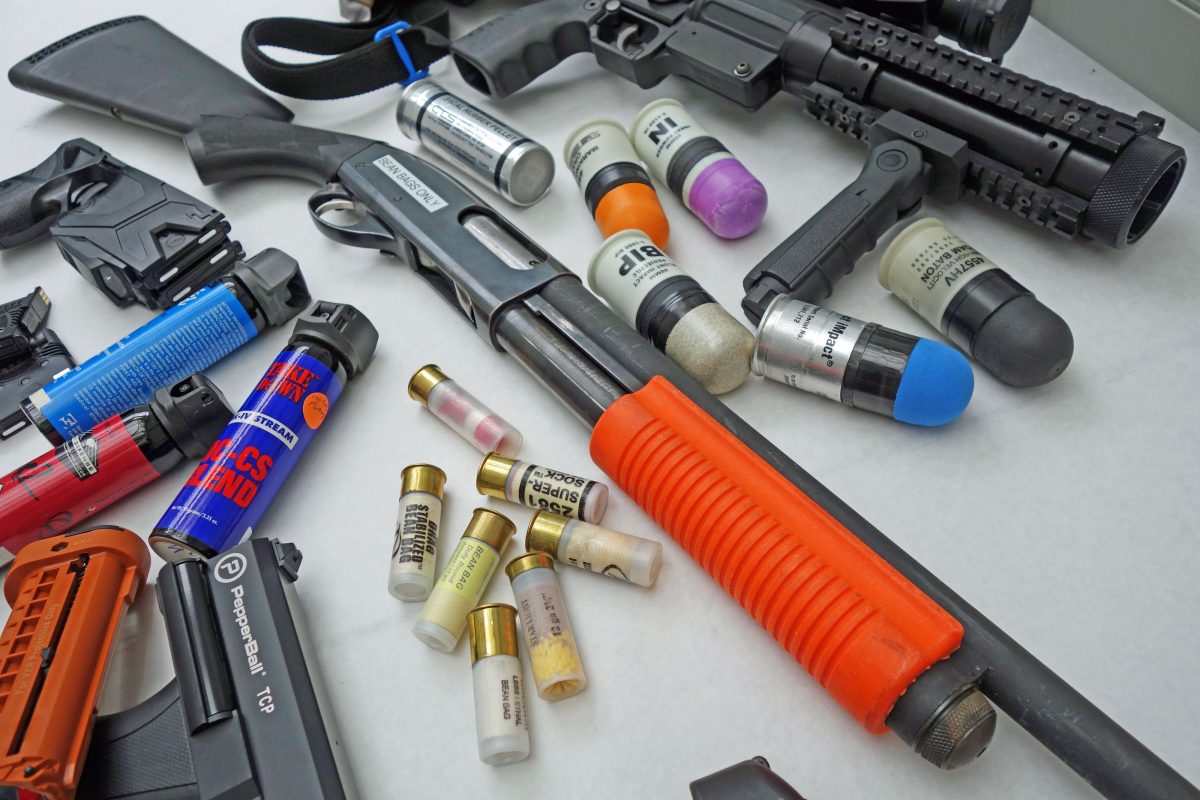Non-Lethal Weapons: Understanding The Role, Types, And Impact In Modern Security
Non-lethal weapons have become a critical component of modern law enforcement and military operations worldwide. These weapons are designed to incapacitate or deter individuals without causing death or permanent injury. Their increasing adoption reflects a shift towards more humane methods of crowd control and self-defense. As the demand for less aggressive tools grows, understanding non-lethal weapons becomes essential for both professionals and the general public.
With growing concerns about excessive use of force, non-lethal weapons provide a viable alternative that prioritizes safety and human rights. They allow law enforcement officers and military personnel to handle volatile situations effectively while minimizing risks to civilians and officers alike. This trend aligns with global efforts to promote de-escalation techniques and reduce fatalities during operations.
This article explores the comprehensive world of non-lethal weapons, including their types, applications, and ethical considerations. By examining the science behind these tools and their real-world implications, readers will gain a deeper understanding of how they contribute to safer communities. Whether you're a professional in the field or simply interested in learning more, this guide offers valuable insights into the evolving landscape of modern security.
Read also:Whats The Meaning Of Odogwu Unveiling The Origins Cultural Significance And Symbolism
Table of Contents
- Introduction to Non-Lethal Weapons
- Historical Development of Non-Lethal Weapons
- Types of Non-Lethal Weapons
- Applications in Law Enforcement
- Military Use of Non-Lethal Weapons
- Emerging Technologies in Non-Lethal Weapons
- Ethical Considerations and Challenges
- Effectiveness and Limitations
- Future Trends and Innovations
- Conclusion and Call to Action
Introduction to Non-Lethal Weapons
Non-lethal weapons represent a significant advancement in modern security practices. These tools are specifically engineered to temporarily incapacitate or deter individuals without causing irreversible harm. Their development stems from the need to address situations where lethal force may not be appropriate or necessary. The primary goal of non-lethal weapons is to maintain order while safeguarding human life.
According to the U.S. Department of Defense, non-lethal weapons are defined as "weapons that are explicitly designed and primarily employed so as to incapacitate personnel or materiel, while minimizing fatalities, permanent injury to personnel, and undesired damage to property and the environment." This definition underscores the importance of balancing effectiveness with ethical considerations.
As society continues to evolve, the demand for non-lethal options grows. Law enforcement agencies, military units, and private security firms increasingly recognize the value of these tools in diverse scenarios, from crowd control to personal protection. Understanding their capabilities and limitations is crucial for their responsible use.
Historical Development of Non-Lethal Weapons
The concept of non-lethal weapons dates back centuries, with early examples including nets, ropes, and bludgeoning tools used in ancient combat. However, modern non-lethal weapons began to emerge during the 20th century, driven by advancements in technology and changing societal values. The invention of tear gas in the early 1900s marked a turning point in crowd control methods.
During the Cold War era, research into non-lethal technologies intensified, particularly within military contexts. The U.S. military's interest in "less-than-lethal" options grew following public backlash against excessive force in Vietnam and other conflicts. By the late 1980s and 1990s, law enforcement agencies began adopting tools like pepper spray and tasers as standard equipment.
Today, the development of non-lethal weapons continues to evolve rapidly, incorporating innovations such as directed energy systems, acoustic devices, and advanced chemical agents. These advancements reflect ongoing efforts to enhance safety and efficiency in security operations.
Read also:Aquafina Actress Husband Exploring The Life Career And Love Story
Types of Non-Lethal Weapons
Non-lethal weapons encompass a wide range of tools and technologies designed to minimize harm while achieving desired outcomes. These can be broadly categorized into several types based on their mechanisms of action and intended purposes.
Physical Restraint Devices
Physical restraint devices include tools that limit mobility or movement without causing permanent injury. Examples include:
- Stun guns and tasers, which deliver electric shocks to temporarily incapacitate individuals.
- Net guns, used to ensnare targets and restrict movement.
- Flexible batons and impact munitions, designed to deliver controlled force without lethal consequences.
These devices are commonly employed in situations requiring immediate control or restraint of individuals.
Chemical Agents
Chemical agents are substances that affect sensory or physiological functions to deter or incapacitate individuals. Common examples include:
- Pepper spray (OC spray), which causes intense irritation and temporary blindness.
- CS and CN gas, used for crowd dispersal and riot control.
- Malodorants, which produce unbearable odors to drive individuals away from specific areas.
While effective, chemical agents require careful handling to avoid unintended consequences or health risks.
Applications in Law Enforcement
Law enforcement agencies worldwide have adopted non-lethal weapons as essential tools for maintaining public safety. These devices are particularly valuable in scenarios involving:
- Protests and demonstrations, where crowd control is necessary.
- Domestic disturbances, requiring de-escalation techniques.
- Arrest situations, where compliance must be achieved without excessive force.
Studies indicate that the use of non-lethal weapons has significantly reduced injuries to both officers and civilians. For instance, a report by the National Institute of Justice found that tasers reduced injuries by 50% in arrest situations compared to traditional methods.
Military Use of Non-Lethal Weapons
In military operations, non-lethal weapons play a critical role in achieving strategic objectives while minimizing collateral damage. They are particularly useful in:
- Peacekeeping missions, where minimizing conflict is paramount.
- Urban warfare, where distinguishing between combatants and civilians is challenging.
- Humanitarian interventions, requiring controlled engagement with local populations.
According to a report by the U.S. Army, non-lethal weapons have proven effective in reducing casualties and fostering better relationships with local communities during deployments.
Emerging Technologies in Non-Lethal Weapons
Advancements in technology continue to drive innovation in the field of non-lethal weapons. Emerging trends include:
- Directed energy systems, such as lasers and microwave devices, capable of temporarily disabling individuals or equipment.
- Acoustic weapons, producing sound waves that cause discomfort or disorientation without causing permanent harm.
- Smart munitions, equipped with sensors and targeting systems to enhance precision and minimize unintended effects.
These technologies hold promise for further improving safety and effectiveness in security operations.
Ethical Considerations and Challenges
The use of non-lethal weapons raises important ethical questions that must be addressed to ensure their responsible deployment. Two key areas of concern include:
Human Rights Implications
While non-lethal weapons aim to minimize harm, their misuse can still violate human rights. Organizations like Amnesty International have raised concerns about potential abuses, particularly in authoritarian regimes where these tools may be used to suppress dissent. Ensuring compliance with international standards is essential to protect individual freedoms.
Ensuring Accountability
Accountability mechanisms are crucial for monitoring the use of non-lethal weapons and addressing any misconduct. Training programs, policy guidelines, and oversight bodies play vital roles in promoting responsible practices. Continuous evaluation and feedback loops help refine protocols and improve outcomes.
Effectiveness and Limitations
While non-lethal weapons offer numerous advantages, they also have limitations that must be acknowledged. Factors such as weather conditions, individual tolerance levels, and equipment malfunctions can impact their effectiveness. Additionally, some individuals may be resistant to certain chemical agents or physical restraints, necessitating alternative approaches.
Research conducted by the United Nations Office on Drugs and Crime highlights the importance of tailoring solutions to specific contexts and scenarios. By understanding these limitations, practitioners can better prepare for diverse operational environments.
Future Trends and Innovations
The future of non-lethal weapons looks promising, with ongoing research exploring new possibilities. Areas of focus include:
- Biometric targeting systems, enabling precise identification and engagement of specific individuals.
- Environmental sensors, providing real-time data to optimize weapon deployment.
- Artificial intelligence integration, enhancing decision-making capabilities and reducing human error.
As technology continues to advance, the potential applications of non-lethal weapons will expand, offering even greater opportunities for enhancing public safety.
Conclusion and Call to Action
Non-lethal weapons have become indispensable tools in modern security practices, offering effective alternatives to traditional methods while prioritizing human life. Their widespread adoption reflects a global commitment to reducing harm and promoting safety in diverse operational contexts. By understanding their capabilities, limitations, and ethical considerations, we can ensure their responsible use and continued development.
We invite readers to share their thoughts and experiences with non-lethal weapons in the comments section below. Your feedback helps inform ongoing discussions and improvements in this vital field. Additionally, explore other articles on our site to deepen your knowledge of related topics and stay updated on the latest advancements in security technology.
For further reading, refer to authoritative sources such as:
- U.S. Department of Defense Non-Lethal Weapons Program
- United Nations Office on Drugs and Crime
- National Institute of Justice

